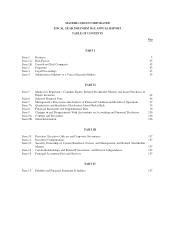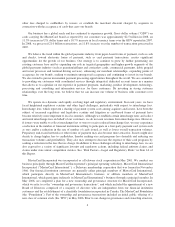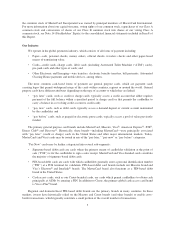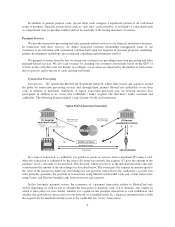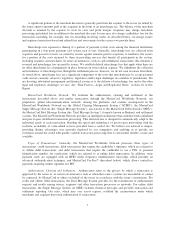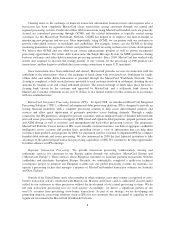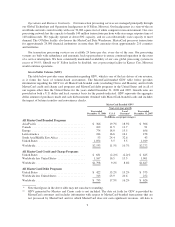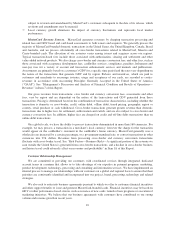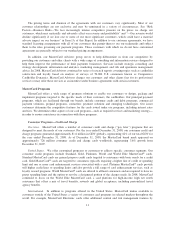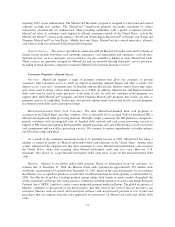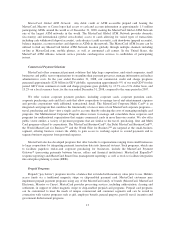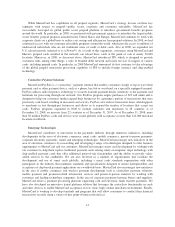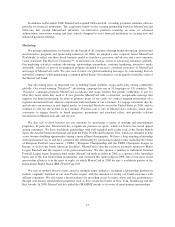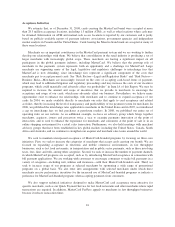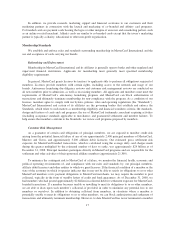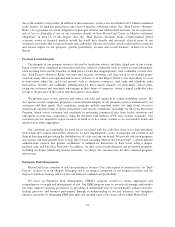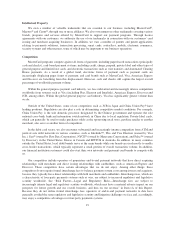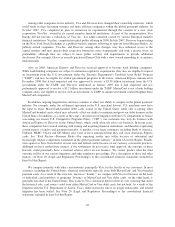MasterCard 2008 Annual Report Download - page 20
Download and view the complete annual report
Please find page 20 of the 2008 MasterCard annual report below. You can navigate through the pages in the report by either clicking on the pages listed below, or by using the keyword search tool below to find specific information within the annual report.subject to revision and amendment by MasterCard’s customers subsequent to the date of its release, which
revisions and amendments may be material.
(2) Local currency growth eliminates the impact of currency fluctuations and represents local market
performance.
MasterCard Revenue Sources. MasterCard generates revenues by charging transaction processing and
related fees and GDV-based and card-based assessments to both issuers and acquirers. We generally process the
majority of MasterCard-branded domestic transactions in the United States, the United Kingdom, Canada, Brazil
and Australia, and we process substantially all cross-border transactions related to MasterCard, Maestro and
Cirrus-branded cards. The allocation of our revenues varies among issuers and acquirers across our regions.
Typical transaction-based fees include those associated with authorization, clearing and settlement and other
value-added network products. We also charge cross-border and currency conversion fees, and other fees, such as
those associated with acceptance development fees, cardholder services, compliance, penalties, holograms and
user-pay fees for a variety of account and transaction enhancement services and manuals and publications.
Assessments are primarily based on a customer’s GDV for a specific time period and the rates vary depending on
the nature of the transactions that generate GDV and by region. Rebates and incentives, which are paid to
customers and merchants to encourage issuance, usage and acceptance of our cards, are recorded as contra-
revenues in accordance with Accounting Principles Generally Accepted in the United States of America
(“GAAP”). See “Management’s Discussion and Analysis of Financial Condition and Results of Operations—
Revenues” in Item 7 of this Report.
Our gross revenues from transactions, cross border and currency conversion fees, assessments and other
fees, vary by region and are dependent on the nature of the transactions and GDV generated from those
transactions. Pricing is determined based on the combination of transaction characteristics, including whether the
transaction is domestic or cross-border, credit, online debit, offline debit, tiered pricing, geographic region or
country, retail purchase or cash withdrawal. Cross-border transactions generate greater revenue than domestic
transactions due to higher fees for settlement, authorization and switch, and are also subject to cross-border and
currency conversion fees. In addition, higher fees are charged on credit and off-line debit transactions than on
online debit transactions.
On a global scale, we have the ability to process transactions denominated in more than 160 currencies. For
example, we may process a transaction in a merchant’s local currency; however the charge for the transaction
would appear on the cardholder’s statement in the cardholder’s home currency. MasterCard generally uses a
wholesale rate increased by a certain percentage, or a government-mandated rate, to convert transactions in other
currencies into U.S. dollars. Revenues from processing cross-border and currency conversion transactions
fluctuate with cross-border travel. See “Risk Factors—Business Risks—A significant portion of the revenue we
earn outside the United States is generated from cross-border transactions, and a decline in cross-border business
and leisure travel could adversely affect our revenues and profitability” in Item 1A of this Report.
Customer Relationship Management
We are committed to providing our customers with coordinated services through integrated, dedicated
account teams in a manner that allows us to take advantage of our expertise in payment programs, marketing,
product development, technology, processing and consulting and information services. We have implemented an
internal process to manage our relationships with our customers on a global and regional basis to ensure that their
priorities are consistently identified and incorporated into our project, brand, processing, technology and related
strategies.
We also seek to enter into business agreements pursuant to which we offer to customers financial incentives
and other support benefits to issue and promote MasterCard-branded cards. Financial incentives may be based on
GDV or other performance-based criteria, such as issuance of new cards, launch of new programs or execution of
marketing initiatives. We believe that our business agreements with customers have contributed to our strong
volume and revenue growth in recent years.
10



